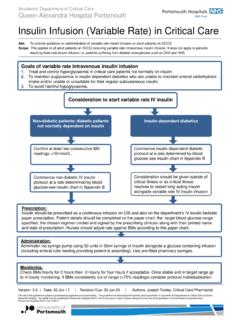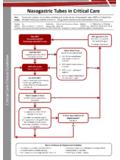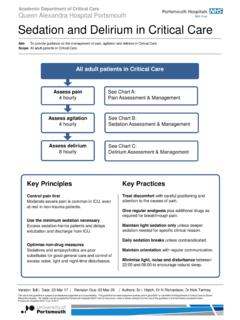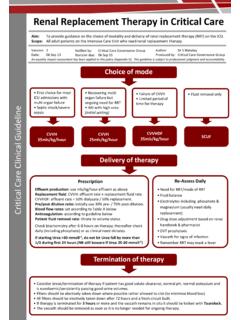Transcription of Academic Department of Critical Care Queen Alexandra ...
1 neuromuscular blockade in Critical care Aim To provide guidance in the optimal administration and monitoring of continuous neuromuscular blockade in Critical care Scope All adult patients in Critical care receiving continuous neuromuscular blockade Academic Department of Critical care Queen Alexandra Hospital PortsmouthVersion: | Date: 01 May 15 | Revision Due: 01 May 17 | Authors: Dr M Ward Jones, N Tarmey The use of this guideline is subject to professional judgement and accountability. This guideline has been prepared carefully and in good faith for use within the Department of Critical care at Queen Alexandra Hospital. No liability can be accepted by Portsmouth Hospitals NHS Trust for any errors, costs or losses arising from the use of this guideline or the information contained herein. Portsmouth Hospitals NHS Trust 2015 Consider continuous neuromuscular blocking agents (NMBAs) for patients with: Give IV loading dose: Atracurium - mg/kg over 1 minute (1st line in Critical care ) Start IV infusion: Atracurium - mg/kg/hr (1st line in Critical care ) If more than two twitches seen or felt: Increase Atracurium infusion rate by 10% Consider bolus dose (discuss with doctor) Repeat train-of-four monitoring in 30 minutes Check TOF every 30 minutes until infusion rate has been stable for two tests.
2 When infusion rate has been stable for two tests, check TOF routinely every four hours. Remember Daily break in NMBA if condition allows Eye and pressure area care Passive physiotherapy Adequate DVT prophylaxis Electrode placement for ulnar nerve stimulation - first choice site for train-of-four monitoring. Place negative (black) electrode closest to hand. Severe respiratory failure requiring advanced ventilation strategies (see Hypoxia SOP) Severe head injury & raised intracranial pressure Shivering during targeted temperature management Uncontrollable muscle spasm or rigidity Discuss with ICU Consultant, check no contraindications, and confirm choice of drug Ensure deeply sedated (eg RASS -5) then test baseline train-of-four (TOF) response. Note the current required: should be minimum needed for maximum response. If fewer than two twitches seen or felt: Reduce Atracurium infusion rate by 10% Repeat train-of-four monitoring in 30 minutes neuromuscular blockade in Critical care .
3 Version dated 01 May 15 2 TABLE OF CONTENTS 1. Introduction 2. Purpose 3. Scope 4. Definitions 5. Duties and Responsibilities 6. Process 7. Training Requirements 8. Monitoring Compliance with, and the Effectiveness of Procedural Documents 9. References and Associated Documents neuromuscular blockade in Critical care . Version dated 01 May 15 3 1. Introduction Monitoring of neuromuscular block is seen as the gold standard for patients receiving neuromuscular blocking agents (NMBA) in the operating theatre and other Critical care areas. It has been suggested that this practice can help to individualise and optimise the dose of NMBA, help to reduce costs by decreasing overall NMBA use1 and reduce the incidents of potential side effects such as prolonged muscular weakness1, however this is contentious, and the published evidence is conflicting2. 2. Purpose This guideline has been created to help guide suitably trained practitioners in monitoring neuromuscular blockade using the Fisher & Paykel Innervator NS242, where required.
4 The guideline will also provide suggestions for management of the patient undergoing continuous neuromuscular blockade . 3. Scope This guideline should be used by suitably trained Critical care practitioners caring for patients undergoing continuous neuromuscular blockade . Ability to comply should not normally be affected under conditions of high demand on services (eg pandemic flu). 4. Definitions neuromuscular blockade The intentional interruption of transmission at the neuromuscular junction by external agents, usually neuromuscular blocking agents. neuromuscular blockade is commonly used to produce muscle relaxation as an adjunct to anaesthesia during surgery and other medical procedures. Train-of-four stimulation A method for measuring magnitude and type of neuromuscular blockade , based upon the ratio of the amplitude of the fourth evoked mechanical response to the first one, when four electrical currents are applied for 2 seconds to a peripheral motor nerve.
5 Depolarising neuromuscular blocking agents suxamethonium. Fast acting muscle relaxant, which causes fasiculation. Depolarising muscle relaxants do not have a reversal agent. They are associated with tachyarrhythmias, hyperkalaemia and malignant hyperthermia. Non-depolarising neuromuscular blocking agents vecuronium and atracurium. These muscle relaxants have a slower onset of action than suxamethonium and have varied duration of action. They do not cause fasiculation. They have no sedative or analgesic effects and do not provoke malignant hyperthermia. Their action may be reversed with anticholinesterases such as neostigmine. Fasiculation A small local contraction of muscles, visible through the skin, representing a spontaneous discharge of a number of fibres innervated by a single motor nerve filament. 5. Duties and responsibilities The registered nurse and doctor are responsible and accountable for the implementation of this guideline and the safety of the patient.
6 They are also responsible for ensuring that the guideline is subject to professional judgement given individual patient situations. neuromuscular blockade in Critical care . Version dated 01 May 15 4 6. Process ACTION Discuss need for neuromuscular blockade with consultant; careful risk/benefit analysis is required Consider using continuous neuromuscular blockade in patients with the following conditions: Severe respiratory failure requiring advanced ventilation strategies Severe head injury with raised ICP Shivering during targeted temperature management Patients with uncontrollable muscle spasm/rigidity ( tetanus) If neuromuscular blockade is required, ensure that the patient is receiving adequate sedation and analgesia prior to administering NMBA. Particular caution should be used if the patient falls into one or more of the following categories: Children Patients with neuromuscular disease Patients with severe burns Patients with severe asthma Patients receiving high dose corticosteroid therapy If neuromuscular monitoring is to be used, carry out train-of-four stimulation prior to commencement of NMBA (discuss with consultant) Atracurium (or cis-atracurium stocked in limited quantities on DCCQ) should be the first choice of NMBA in continuous blockade .
7 RATIONALE The use of neuromuscular blocking agents (NMBA) carries potentially serious risks, and therefore should be used only when necessary. NMBA may aid ventilator synchrony and lower systemic oxygen consumption, thus helping to optimise cerebral perfusion if ICP is raised, and gas exchange in severe respiratory failure. There is evidence that a continuous infusion of NMBA reduces mortality in ARDS3. NMBA can also reduce muscle rigidity and facilitate patient positioning1,2. Sedation and analgesia are required to prevent patient awareness whilst in a state of imposed paralysis as this could be extremely unpleasant for the patient1. NMBA have no sedative, analgesic or amnesic properties. These patients may have an altered response to neuromuscular blocking agents1,2. Patients with some neuromuscular diseases and those receiving high dose corticosteroids are at risk of prolonged muscle weakness following NMBA use2.
8 Patients with burns may become resistant to the effects of NMBA, and those with asthma may be at risk from histamine release with atracurium4. This allows for a baseline measurement, and allows the practitioner to work out how much current is required to evoke a muscular response1. Using the minimum amount of current will reduce discomfort to the patient5. Atracurium may be less likely to cause prolonged muscle weakness than aminosteroid NMBA. Atracurium is only partially eliminated by renal and hepatic metabolism, and may therefore be safer to use in multi-organ dysfunction than some other agents2. Evidence for NMBA improving mortality in ARDS only exists for cis-atracurium use3. neuromuscular blockade in Critical care . Version dated 01 May 15 5 ..continued ACTION (continued) A bolus dose of atracurium should be given prior to infusion to ensure that an adequate block is achieved.
9 This should be given slowly (over around one minute). Bolus dose (in mg) and starting infusion rate (in ml/hr) should be prescribed by the doctor with responsibility for the patient. If train-of-four monitoring is used, it should be carried out every 30 minutes until the infusion rate has been stable over the last two tests. It should then be carried out every four hours unless the infusion rate changes. The infusion of NMBA should be titrated so that 2 twitches are seen or felt on train-of-four stimulation (if used). If more than 2 twitches are seen/felt then increase infusion rate by 10% and consider a bolus dose (discuss with a doctor). If less than 2 twitches are present then reduce infusion rate by 10%. Train-of-four stimulation should be carried out on the ulnar nerve according to manufacturer s instructions. Patients undergoing continuous neuromuscular blockade should have regular eye care , passive exercises, pressure area care , and adequate DVT prophylaxis.
10 RATIONALE (continued) Histamine release after administration of atracurium can cause bronchospasm. If the bolus dose is given slowly, it may ameliorate this response6. Recommended bolus dose is with infusion starting at Requirements for infusion rates as high as have been reported4. This recommendation is based on expert opinion only1,2. The only good quality study demonstrating improved outcomes in ARDS used a fixed-dose infusion of cis-atracurium without neuromuscular monitoring3. Other published evidence suggests train-of-four monitoring is not superior to clinical assessment alone7,8. The aim of continuous neuromuscular blockade is to provide a block of approximately 90% at the neuromuscular junction (though this requirement varies somewhat depending on the indication for NMBA). This equates to 2 twitches in train-of-four monitoring. These recommendations are based on expert opinion only2.




